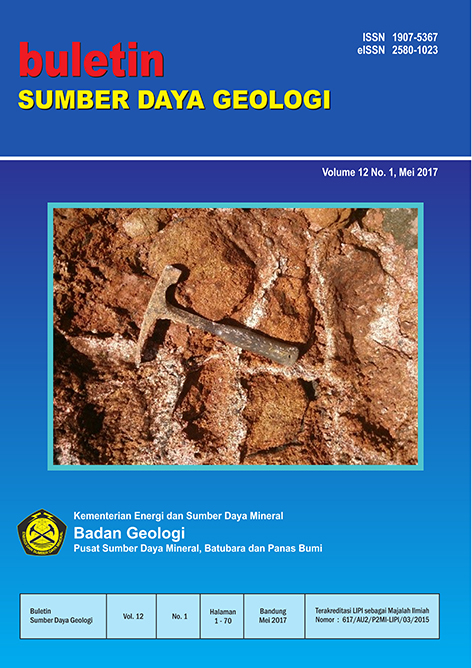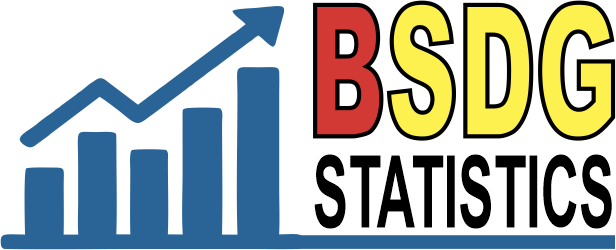POTENSI ENDAPAN PASIR DAN GUMUK PASIR HUBUNGAN NYA DENGAN BATUAN INDUK DI PANTAI PAMEUNGPEUK, KABUPATEN GARUT, PROVINSI JAWA BARAT
Abstract
Potensi sumberdaya pantai daerah penelitian di pantai perairan Pameungpeuk dan sekitarnya, yaitu:sedimen pasir dan gumuk pasir.Tujuan dari tulisan ini adalah untuk mendapatkan data dan informasi sedimen pasir dan gumuk pasir di daerah penelitian dan hubungan nya dengan batuan induk.Metoda penelitian terdiri dari pemetaan karakteristik pantai, pengambilan sedimen pantai, bor tangan pantai, analisisi besar butir dan analisis mineral.
Berdasarkan karakteristik pantai di daerah penelitian terdiri dari pantai berpasir putih, pantai berpasir coklat dan pantai berpasir hitam.Pantai berpasir hitamdidominasi oleh mineral magnetit, pantai berpasir coklat didominasi oleh mineral magnetit dan sedikit pecahan cangkang moluska, pantai berpasir putih didominasi oleh pecahan cangkang. Berdasarkan analisis mineral di daerah penelitian terdiri dari magnetit, hemati, limonit, ilmenite, rutil, hornblenda, piroksen, augit.diopsid, biotit dan epidot
Berdasarkan pengukuran dengan theodolit pada pantai bergumuk pasir, memiliki kemiringan pantai sedang hingga tinggi (slope 21° - 60°), dengan lebar pantai bervariasi mulai dari 30 meter sampai 60 meter, serta tinggi gumuk pasir mulai dari 3 meter sampai 6 meter.
Downloads
References
Alzwar, M., 1992, Peta Geologi Lembar Pameungeuk, Jawa Barat, PPPG, Bandung
Bird, E. 2008. Coastal Geomorphology, an introduction, second edition, John Willey & Sons.
P. 331 – 332. P. 247 – 269.
Davidson, R. And Arnott. 2010, Introduction to coastal processes and Geomorphology, Cambridge University Press.
Dolan, R., Hayden, B.P., and Vincent, M.K., 1975, Classification of Coastal Land form of the America, Zeithsechr Geomorphology, Encyclopedia of Beaches and Coastal Environment.
Folk, R.L., 1980, Petrology of Sedimentary Rocks, Hamphill Publishing Company Austin, Texas, 170 – 174.
Friedman, G.M, and Sanders, 1978, Principles of sedimentology, John Wiley & Son.
Koesoemadinata, 1980, Prinsip-prinsip Akrasi, Jurusan Geologi, ITB, Bandung.
Komar, D. P. 1998, Beach Processes and Sedimentation, Second Edition, Oregon State University.p.33 -71.
Lewis, D.W., 1984, Practical Sedimentology, University of Canterbury, New Zealand.
McCave, I.N., and Syvitski, J.P.M., 1991, Principles and methods of particle size analysis, In J.P.M. Syvitski (ed.), Principles, Methods, and Applications of Particle Size Analysis, New York, Cambridge University Press, p. 3-21.
Reading, H.G., 1979, Sedimentary environments and facies, Department of Geology and
Mineralogy university of Oxford.
Short, A. D. (2012) Coastal Processes and Beaches. Nature Education nowledge University
of Sydney, NSW.
Smith R L, & Smith T M, 1998, Elements of Ecology 9th edition,Univerdity of Virginia, San Francisco USA.
Susilohadi., 1985, Perangkat lunak program nomenklatur sedimen dan moment, Pusat Penelitian dan Pengembangan Geologi Kelautan. (laporan intern PPPGL).
Weggel, J. Richard (author); Weggel, David C. 2006.Development of a coastal sand dune management program The Seventh International Conference on HydroScience and Engineering (ICHE) hosted by the College of Engineering at Drexel Univeristy in Philadelphia,Pennsylvania.
Copyright (c) 2017 Buletin Sumber Daya Geologi

This work is licensed under a Creative Commons Attribution-NonCommercial-ShareAlike 4.0 International License.
Authors whose manuscripts are published agree to the following terms:
The publication rights of all journal manuscript materials published on the Buletin Sumber Daya Geologi website are held by the editorial board with the knowledge of the author (moral rights remain with the manuscript’s author).
The formal legal provisions for access to digital articles in this electronic journal are subject to the terms of the Creative Commons Attribution-ShareAlike (CC BY-SA) license. This means that Buletin Sumber Daya Geologi has the right to store, convert media/formats, manage in the form of a database, maintain, and publish the article without requesting permission from the author, as long as the author’s name is cited as the copyright holder.
Manuscripts published in both print and electronic formats are open access for educational, research, investigative, and library purposes. Beyond these purposes, the editorial board is not responsible for any violations of copyright law.















